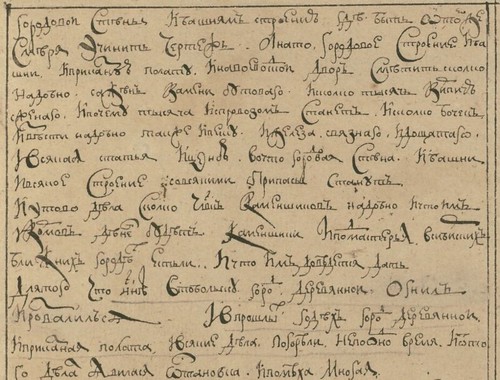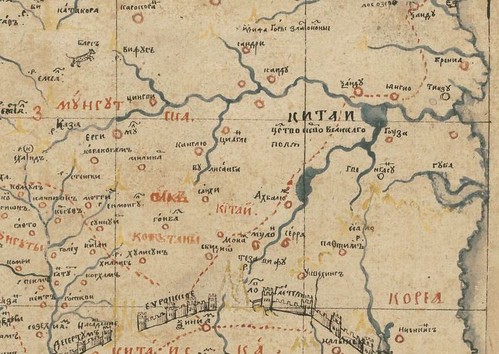Via @bibliodyssey, Semën Ul’ianovich Remezov’s Khorograficheskaya Kniga.
By the mid-17th century, Russian development in Siberia extended all the way to the Pacific, but from the seat of Russian power in Moscow, there was still little known about the area. By all reports there were at that time no maps of Siberia in Russia and so, seeking to collect knowledge and understanding of their extended interests in the area, late in the 1600s, the Siberian Court Office of Moscow ordered the production of a number standardized settlement maps. Cities and towns were to be represented and notes made on surrounding features of the land, particularly their situation on rivers and the native settlements within certain proximities.
Throughout Siberia, land-surveyors and draftsmen were recruited to do work on this massive project, but one notable man in Tobol’sk, Semën Ul’ianovich (alternately, Semyon Ul’yanovich) Remezov, would emerge as the primary cartographer of the region, creating, by the estimate of historian James R. Akerman, some 80 percent of the surviving Siberian maps of his century. Akerman’s biographical sketch of Remezov tells a compelling story: a low-level government administrator who brought creative energy to his census registry work, compiling ethnographic data in the depths of Siberia, a “restless” intellect who contributed much to his city of Tobol’sk, and an artist who would capture a dynamic sense of Siberia on page after page of beautifully rendered maps. *
Siberia, especially in it’s less than accurate usage meaning ‘all that stuff east of the Urals’, is HUGE, my knowledge of the geography of the are is limited and my ability to read Cyrillic script and/or Russian is nonexistent. As a result, this atlas is for me like a dispatch from another planet – Borges and Tolkien do some mapping.
*
I’m wondering if this could be the maritime province – Primorsky Krai? Great Wall at the bottom, Korea to the east, and the Amur and Ussuri watershed center. If so, that’d be an Amur Leopard gamboling about in the upper left.
-+-
Via the consistently great Five Books, Robert Chandler on Tales of Soviet Russia.
The Soviet writer he [Vasily Grossman] was closest to was Andrey Platonov and the stories do have quite a Platonov-like quality to them. There is one about a dog, just called ‘The Dog’, and it’s quite close to reality. There were several mongrel dogs that were sent up into space on the early sputniks and this is a story about the first dog to be sent up into space and to come back alive to earth.
Laika? No. She died, didn’t she?
Laika died. That was the very first dog. This is the fictionalised successor to Laika and it’s very unexpected. I showed it to a poet friend called Elizabeth Cook and her immediate comment was that it was really shamanistic! It would never have occurred to me but actually it’s a valid comment. The heroes of the story are the female dog and the scientist in charge of the laboratory, a really hard-headed, unsentimental scientist who, to everyone’s amazement, gets quite besotted by this animal, and he has visions of her going out into space and for the first time the cosmos will penetrate the eyes of a living being. And somehow he will look into her eyes when she’s back on earth and will see the cosmos. It’s very warm and tender and funny, and there’s a certain irony to these mystical ideas, but some seriousness to them as well. Quite a lot of them are about animals.



Though the towns– such as they are– do not correspond much to ‘modern’ ones, I think it IS Primorskye in the far upper right– and I do read a bit of Cyrillic (;-))
Mongolia seems to make it into the west- not sure about scale!